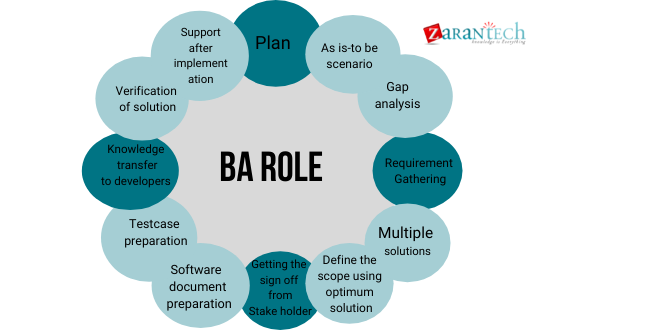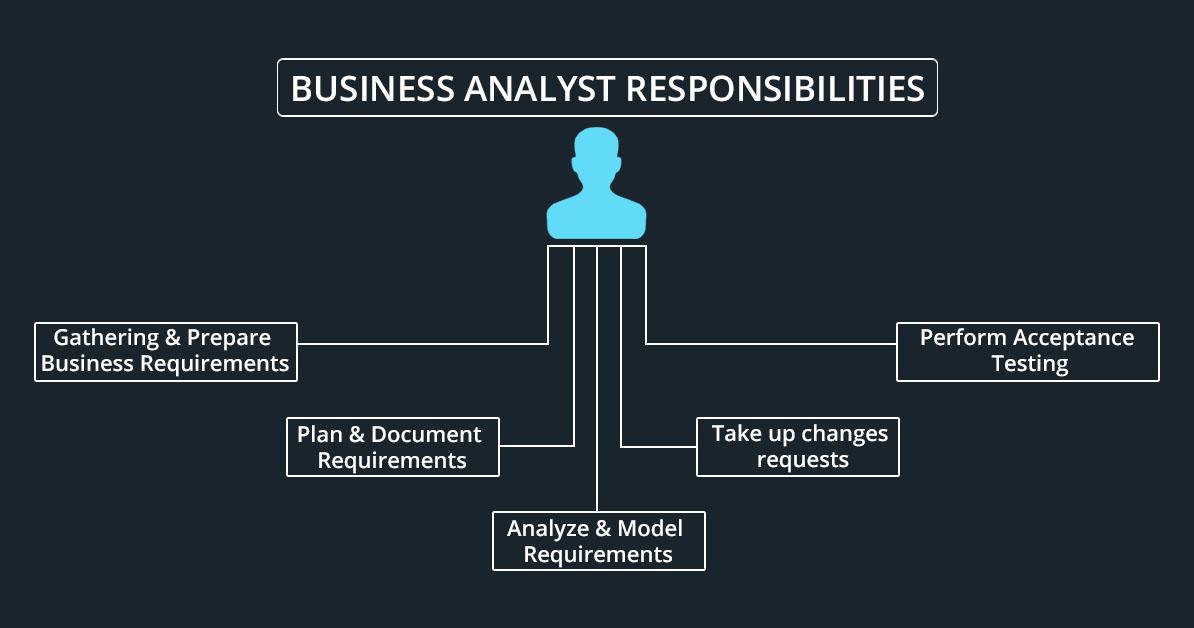Top 10 Responsibilities of a Business Analyst
Category: Agile Business Analysis Posted:Mar 08, 2017 By: Serena Josh
At these times, “Business Analyst” is the popular term or designation that is used in the circles of business. Many people become amazed, if you introduce yourself, as you’re a BA or Business Analyst. Since it makes people sense good about your career, then it undoubtedly must be a worth field!
If you want to be, an aspirant Business Analyst, then you should have a clear idea of What a BA does and what are their roles as well as responsibilities to do at their workplace. Generally, a Business Analyst is required, when the organization’s scale of operation is medium to high. Hence, this is another positive thing about being a BA. This is a healthy indication of an outstanding career in today’s job market. If you want to know something about a day in the Business Analysts’ life, then you have reached the right place. Here we provided the top 10 responsibilities of a Business Analyst. Let us begin with who Business Analyst is.
Who is a Business Analyst?
Business Analyst analyzes the enterprise and design organizations, ministries as well as non-profit organizations. Business Analysts analyze the business models as well as their association with technology. Business Analysis includes at least four levels. They are as follows:
- Strategic Planning– This level of analysis includes the evaluation of strategic activities of the company must.
- Business / Operation Model Analysis– This level includes the identification as well as evaluation of policies and procedures of the organization to do business.
- Process Definition & Design– This level of analysis includes the business process modeling, which is often the outcome of process design and modeling.
- IT & Technology Business Analysis– This level encompasses the rules as well as needs for technical systems. This analysis is usually encountered in the IT field.

Overview of Business Analyst Role
A Business Analyst can able to work as a core intermediate of the company. The role of a Business Analyst proceeds on several dimensions as well as responsibilities, which all match in to the huge domain of the core businesses of the organization. The core businesses of any company are packed with processes and the successful working of these processes is under the responsibility of the Business Analyst, nominated for that specific project. The primary role of a Business Analyst includes generating ideas for new processes, developing them, and very essentially implementing them to ensure that they’re functioning well.
In addition, a Business Analyst requires guaranteeing these processes are organized in a way, which permits those processes to be modified to other portions of the company. He includes a clear understanding of how the processes are functioning currently in the environment of the business; hence, he can able to realize how operative it is and after measuring the worthiness, he can identify the gaps and then find the solutions to plug them. He also ensures to prevent those gaps in the new processes.
Since Business Analyst serves as the core processes of a business in the company, he needs to communicate with several departments of an organization. Communication with the uppermost position or top management of the company is an essential role of a Business Analyst. Moreover, he needs to interact with the company’s Salesforce, Marketing Department, Finance & Accounting department, the Production department, and the human resource department as a part of this role. He/she also requires to aware of the customer’s consumer behavior, which is influenced by the organization’s businesses. In addition, the job of a Business Analyst isn’t static in nature. He requires being dynamic, well in his ideas, action, and words. In order to survive in the constantly changing phase of the corporate market, Business Analysts are demanded to review their processes constantly in their business unit and make required changes if necessary. This behavior is vital to guarantee maximum customer fulfillment for the consumer of an organization and for business profitability optimization.
You may also like to read this- Why it is critical to define the business requirements?
Top 10 Responsibilities of A Business Analyst

1. Understand the Requirement of the Businesses
A vital responsibility of the Business Analyst is to function with the project stakeholders to understand their requirements and translate them into details, that developers can able to understand. Moreover, to translate the emerging question from the developers into details that stakeholders can able to understand. The key skill required for this portion of the process is the ability of the Business Analyst to refine the varying messages as well as the requirements of the project stakeholders or consumers into a consistent, single vision. This task sometimes includes certain political and negotiation maneuvering. Business Analysts often need to spend a certain amount of time in the meetings in order to save the development team from spending their time understanding the stakeholder’s requirement.
2. Possibilities of the System
At the beginning of the project, the role of a Business Analyst may seem like one among the software development team designated for the project. However, they are required to work with key project consumers or stakeholders as well as business people to communicate and formulate the vision of the business for the project. In addition, BA is in needs to plot the scope and initial requirement of the project. The fundamental goal of the BA is to obtain the project concentrated early by transforming the initial high-level goal into something realistic.
3. Presentation & Public Speaking
For Business, it is paramount important to value the creating as well as delivering a quality presentation on the topics like project status, application designs as well as business requirements. Generally, people listening to the presentation of the Business Analyst are the senior business and IT management people. The main responsibility of the Business Analyst is to impress the stakeholder and other authorities with their presentation, which would have a notable effect on the growth of the business.
Checkout the Article- Steps to being an Effective Business Analyst
4. Elaborate the Details of the Project
The most important responsibility of the Business Analyst is elaborating the details. This is where he gets into evaluating the needs and guarantee the implementation team has the entire details, they require creating or implementing the process. Most probably, this phase includes working with a wide range of stakeholders or consumers across the company to guarantee their needs, as well as knowledge, are combined into a detailed conversation about what they will actually build. In a conventional or a waterfall environment of a business, this phase is integrated with beginning the project and it covers the judgment of whether to fund the project or not. In many cases, this phrase has taken a bit later, after the time and trust of the stakeholder is absorbed. Based on the project, BA requires a data model or specification as well. Regardless of how BA chooses to mention, this phase needs to complete when the stakeholder or customer has signed off on the agreement of what will get implemented and the developers have awareness of what they have to design as well as implement the project.
At several companies today, this project phase is taken in an iterative way. That means that the Business Analyst prepares the functional specifications and other requirements in a phase that are accepted by the organization and then the development team of the company designed as well as implemented. User stories and use cases are more suited to this kind of iterative strategy when compared to a single functional specification. As a particular set of needs is preparing for the development to begin, the role of BA typically changes from an active side to a reactive side.
5. Support the Project Implementation
The Business Analysts involved in the implementation support through life cycle end. Business Analyst is not generally involved in the implementation directly unless they are holding extra roles on the designated project. However, they’re naturally brought in, if there are problems that come up at the time of implementation, which cause some new additional needs to be addressed. This support could involve enabling a problem-solving meeting to identify how certain business requirements can be met provided newly identified technology constraints.
For instance, when redesigning a website, it is needed to form an assumption regarding how the author outlines would work. Then we found that the WordPress no longer allows the functionality we required. Then we are in need to revise the author outlines page and find a simple as well as an elegant solution.
As the task of implementation is finished, often Business Analysts need to have a more active task. They might be required to support the business to accept the new solution, which is being implemented. This task involves analyzing how the stakeholder or consumers will utilize the new solutions in order to complete certain activities and tasks. This task can also encompass user documentation, training, or acceptance testing. It is becoming common for the Business Analyst to proceed to take part in the project via this stage. This phase is over when the project is delivered to the production environment and the stakeholders of the business are capable of accessing it successfully in their jobs. Of course, at this process of solution implementation, new requirements, as well as needs, are discovered and the Business Analyst might receive new projects to start and the entire cycle continues again.
6. Functional Requirements and Non-Functional Requirements
Attaining a successful end product is one of the roles as well as responsibilities of a Business Analyst. He should determine what the project should do and how the project should work. In the terms of Business Analysis, these are referred to as functional (What the project should do) and non-functional (how the project should work) requirements. The functional, as well as non-functional requirements, serves a role in mentioning the abilities of the completed service or product. As the categories are matured, greater importance is provided to the non-functional requirements. The main reason for this is that once the product attains its place in the real environment, you can start developing on what it ensures to raise its value.
7. User Acceptance Testing
The responsibilities of the Business Analysts do not end up with the identification of the needs and requirements of the project. Ensuring that the product is functioning well as it is designed for, in addition to ensuring the product delivered satisfies the user requirements is one of the most vital responsibilities of the Business Analyst. User Acceptance Testing is the only possible and accepted way to ensure this. While the product in the development as well as deployment stages, Business Analysts should actively function on developing user-testing scenarios via testing approaches. The best indication of user acceptance is that the product will offer the expected result.
8. Technical Writing, Decision Making & Problem Solving
The main role of Business Analysts is the building of business requirements specification, as well as other phases of documentation. They are in need to develop informative, coherent, and usable documents for professional success. When it comes to decision making, there are several formalized techniques are available, including decision matrix, which can support to make business-appropriate, quality as well as defendable decisions, which can support to offer the best service for the internal clients and enhance the performance. As similar to decision making, there are several formalized problem-solving techniques like Brainstorming and Five Whys, which can support to identify the root cause of a problem and define powerful solutions.
9. Maintenance of System and Operations
Once the entire requirements have been addressed and the solution offered the role of Business Analysts moves to preventing or correcting defects, making changes, enhancements, and maintenance of the system to enhance the value of the system. They also involved in providing maintenance reports, system validation reports, deactivation plans as well as other plans and reports of other documents. The Business Analysts will also involve in evaluating the system to find when the replacement or deactivation is needed.
10. Team Building
It is an inevitable responsibility of a Business Analyst. They are required to lead ad hoc or formalized teams. They are in need to coordinate, structure, and lead these team members to make their role more successfully.
Go through our Business Analysis Interview Questions to crack the Interviews
Conclusion
For more such informative and engaging articles on Business Analysis, feel free to visit our website. I hope that by now you have had an overview of SAP Successfactors. Before you enroll in ZaranTech’s certification course on Agile Business Analysis do check out this demo video:




 99999999 (Toll Free)
99999999 (Toll Free)  +91 9999999
+91 9999999